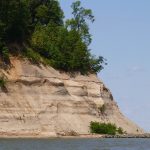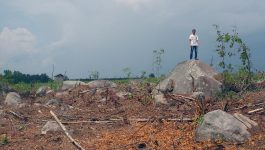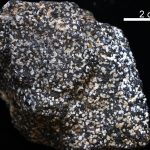
The Rappahannock River forms a broad estuary as it flows to towards the Chesapeake Bay in Virginia’s Coastal Plain province. To the south the Piankatank River is also visible. The Rappahannock and Piankatank rivers are tidal estuaries.
A Resource for Information on the Commonwealth's Geology

The Rappahannock River forms a broad estuary as it flows to towards the Chesapeake Bay in Virginia’s Coastal Plain province. To the south the Piankatank River is also visible. The Rappahannock and Piankatank rivers are tidal estuaries.

The Cliffs of Westmoreland rise 30 to 45 meters (~100 to 150′) above the waters of the Potomac River. These bluffs expose Miocene to Pliocene sedimentary units, some which are quite fossiliferous. For more information on the geology of Westmoreland checkout the 2005 Virginia Geological Field Conference guidebook by Buck Ward and others. Note the […]

Finding bedrock outcrop in the Piedmont of Southside Virginia can be challenging. Much of the terrain is covered by soil and saprolite, and geologists interested in this region must search high and low for outcrop. The image above illustrates a ‘good’ natural outcrop in the Piedmont, likely the result of a relatively resistant rock that […]

On July 1, 2016, Governor Terry McCauliffe signed a bill into law that made nelsonite the first official state rock of Virginia. The initiative for this project was led by students from Piedmont Virginia Community College. Michelle Stanislaus and her classmates from their Historical Geology class and Government class ran the petition for this law starting […]
Copyright © 2025 · Backcountry Child Theme on Genesis Framework · WordPress · Log in